Earwigs, slaters and millipedes are topical when it comes to establishment of broadacre crops in the south-east, particularly in canola.
Often recognised as stubble pests with similar management options, it’s tempting to refer to them collectively.
But ambiguities in pest status and damage potential means this pest trio warrants a more nuanced discussion. Here are four points worth considering when trying to work out if these pest groups will cause damage on farms.
1. Not all earwigs, slaters and millipedes are pests.
When considering earwigs as pests in broadacre winter crops in the south-east, it is largely one species, the European earwig (Forficula auricularia).
You may spot other earwig species on farms. Recent research has revealed 10 species in Australian grain crops. For example, the black field earwig (Nala lividipes) was recently spotted in a canola crop in Northern Victoria, however this species is not known to reach pest status in the south-east like it does in the northern grains cropping region. There’s also the native, common brown earwig (Labidura truncata), a generalist predator that feeds on some soft-bodied insects like moth larvae.
Like earwigs, there is one main species of millipede which is a pest in south-eastern broadacre crops, the black Portuguese millipede (Ommatoiulus moreletii), while there are many other native species which are unlikely to cause problems.
Slaters as a pest group on the other hand mostly refers to two species, the pill bug (Armadillidium vulgare) and the common rough slater (Porcellio scaber).
2. Pest species are not always pests.
The black Portuguese millipede, pill bug and common rough slater are detritivores which breakdown dead organic matter in soils and plant litter (detritus), playing a beneficial role in agricultural ecosystems.
They don’t need living plants to persist and survive.
Despite this they can sometimes feed on some establishing crops in Australia. We have seen it in laboratory experiments and have received reports of damage from growers and agronomists over the years.
The issue is that we do not understand what triggers these species to turn their attention to crop plants in some circumstances. Nor can we predict under what conditions damage is likely to occur.
Even the omnivourous European earwig, which arguably engages in more destructive and voracious pest like behaviour compared to the black Portuguese millipede, pill bug and common rough slater, can partly play a beneficial role by predating on aphids.
3. The culprit isn’t always clear-cut.
The black Portuguese millipede, pill bug and common rough slater can build up in quite high numbers on farms, particularly in stubble-retained systems. Their mere presence coupled with crop damage, means that it is easy to point the finger at these pest groups.
However, it is worth taking the time to make sure that they are the ones responsible for the damage. As mentioned, these species are detritivores and don’t normally feed on crops.
When it occurs, feeding by slaters and millipedes creates typical ‘chewing’ damage (e.g. chewed foliage, severed stems, missing cotyledons) and can be mistaken for feeding by other establishment pests including the European earwig, beetles, moth larvae, slugs and snails.
If practical, direct searching at night with a torch will go a long way to help identify the source of damage. This can be particularly useful if there are multiple suspects present in a paddock, but you are unsure what is doing the damage.
4. Not all crops are at risk.
Researchers have been looking into which crops are susceptible to feeding damage from different species, and not all broadacre crops are equally impacted by earwigs, slaters and millipedes.
The results of these studies have been categorised and represented in the following table:

This is a high-level summary; it can be used to get a general idea of whether earwigs, millipedes or slaters are known for causing damage in different crop types, and whether additional control measures may be required.
We are always collecting more information on this topic, so if you’ve been getting out at night and found an expected or unexpected culprit, we’d love to hear from you.
Acknowledgements
Thanks to Associate Professor Paul Umina for the crop susceptibility table.
Cover image: Provided by Scott O’Sullivan





